How To Repair A Drawer Front
Repairing a drawer front
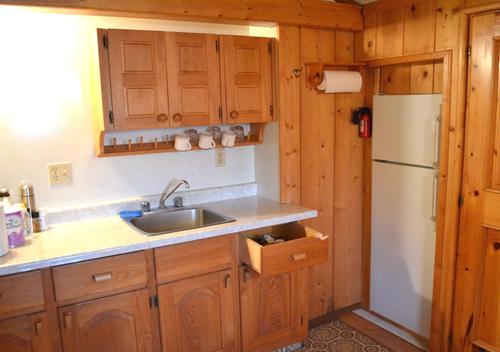 Anybody who lives where there are trees probably knows how destructive squirrels can be. At my parent's "Amogla camp", a squirrel somehow got into a drawer in one of the cottages, and it decided to get back out by chewing its way through the front end of the drawer.
Anybody who lives where there are trees probably knows how destructive squirrels can be. At my parent's "Amogla camp", a squirrel somehow got into a drawer in one of the cottages, and it decided to get back out by chewing its way through the front end of the drawer.
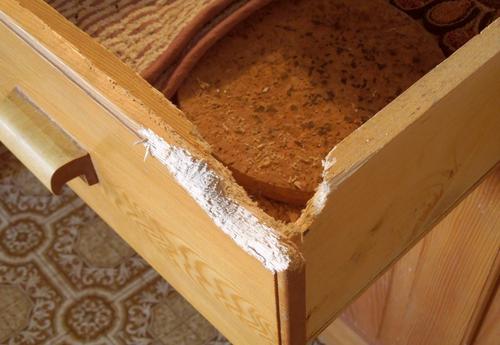 A whole corner of the drawer was chewed off!
A whole corner of the drawer was chewed off!
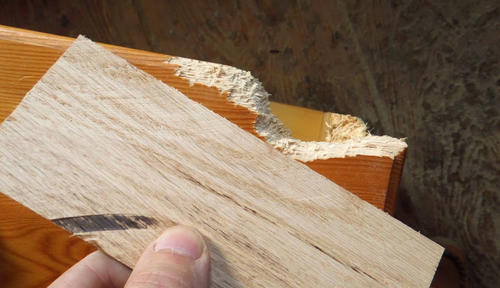 To fix it, I figured it was best to replace the corner by making a diagonal cut so I'd have a straight and apartment surface to join a new piece onto.
To fix it, I figured it was best to replace the corner by making a diagonal cut so I'd have a straight and apartment surface to join a new piece onto.
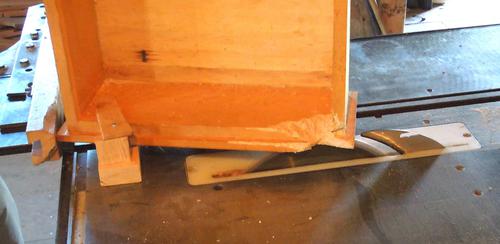 Because it'due south far from my shop, I used my dad's workshop.
Because it'due south far from my shop, I used my dad's workshop.
I jigged upward the drawer on the sled of his Felder table saw to make the diagonal cut. The sliding table came in handy for that.
Initially, I only cutting function manner (as shown in the photo), but later cut much deeper to cut abroad the entire front and some of the side of the drawer too.
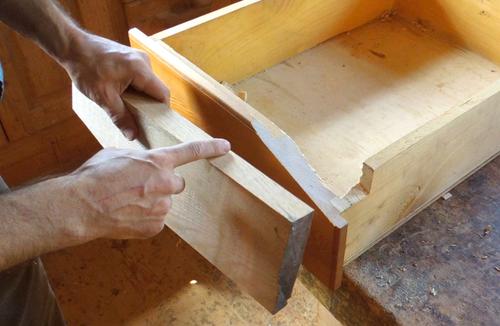 Here's a piece of oak of nigh the correct thickness to make the new corner from.
Here's a piece of oak of nigh the correct thickness to make the new corner from.
The drawer, and the whole kitchen fronts were made from Hemlock. I couldn't find whatsoever of that forest in my dad's shop. Hemlock isn't commonly used for furniture. Information technology splinters hands, so it'south hard to work with.
I apply a piece of oak for the repair. Over time, that should darken to a similar colour every bit the existing drawer.
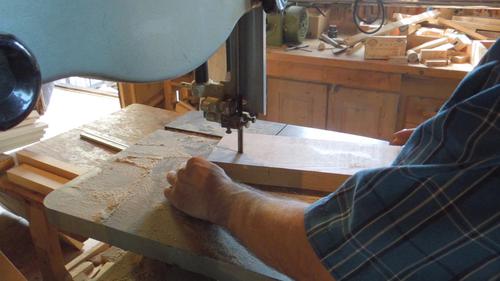 Cutting a triangular piece off the forest on my dad'southward eighteen-inch bandsaw. That bandsaw is way out of aligning, and the blade is quite wobbly. I ever intended to give information technology tune-upwardly at some point, but in the concurrently, I started building my own bandsaws.
Cutting a triangular piece off the forest on my dad'southward eighteen-inch bandsaw. That bandsaw is way out of aligning, and the blade is quite wobbly. I ever intended to give information technology tune-upwardly at some point, but in the concurrently, I started building my own bandsaws.
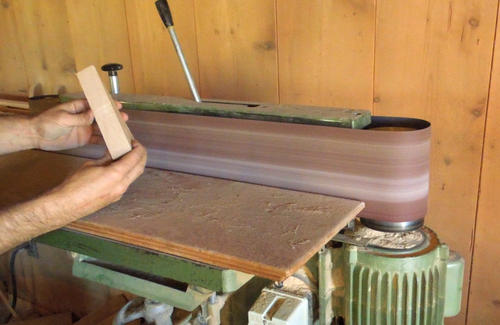 Smoothing the bandsaw cut on the belt sander. In my shop, I would have used the jointer, simply my dad's 12-inch jointer has a v-inch (125 mm) diameter cutter head, with a much larger gap between the tables, making it dangerous for small workpieces.
Smoothing the bandsaw cut on the belt sander. In my shop, I would have used the jointer, simply my dad's 12-inch jointer has a v-inch (125 mm) diameter cutter head, with a much larger gap between the tables, making it dangerous for small workpieces.
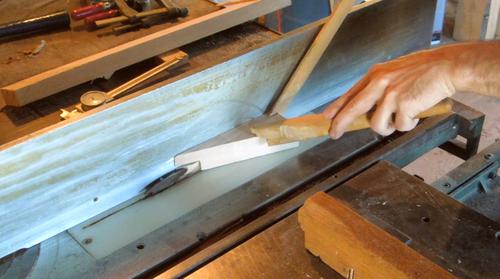 Next adding the rabbet around the edges by making two cuts from each side on the tabular array saw.
Next adding the rabbet around the edges by making two cuts from each side on the tabular array saw.
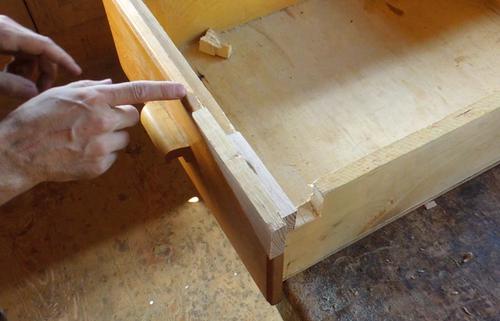 Checking the fit. Overall dimensions are ok. But the drawer has a slight profile cut into the edges of it.
Checking the fit. Overall dimensions are ok. But the drawer has a slight profile cut into the edges of it.
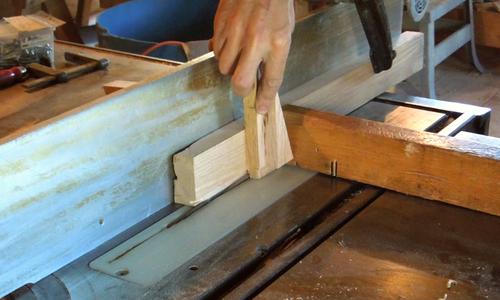 I didn't feel like trying to find a suitable router or shaper bit to reproduce this profile. Instead, I cut a rectangular approximation of the contour on the tabular array saw.
I didn't feel like trying to find a suitable router or shaper bit to reproduce this profile. Instead, I cut a rectangular approximation of the contour on the tabular array saw.
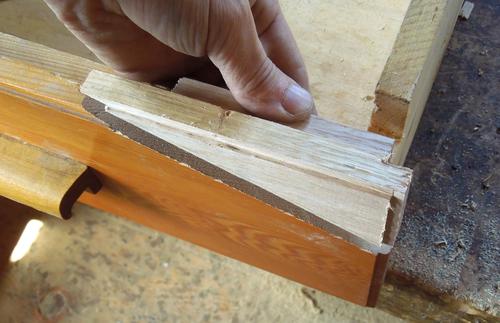 Another check. Looks virtually right.
Another check. Looks virtually right.
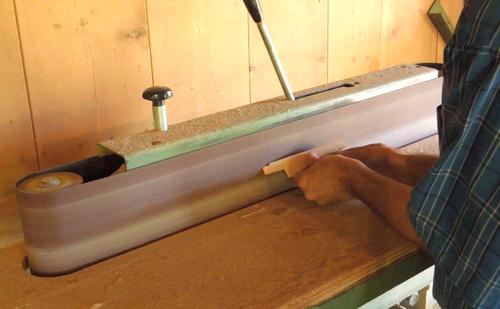 The outside corner needs a round-over applied to it. This being simply a small workpiece, I approximated that using the belt sander.
The outside corner needs a round-over applied to it. This being simply a small workpiece, I approximated that using the belt sander.
I really like this style of belt sander. With the belt oriented vertically, it's much easier to see work in progress than on my belt sander.
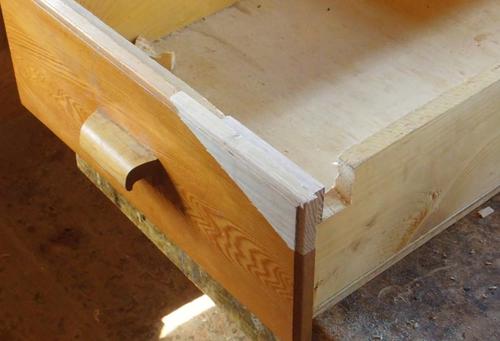 Done shaping the piece. Everything lines up.
Done shaping the piece. Everything lines up.
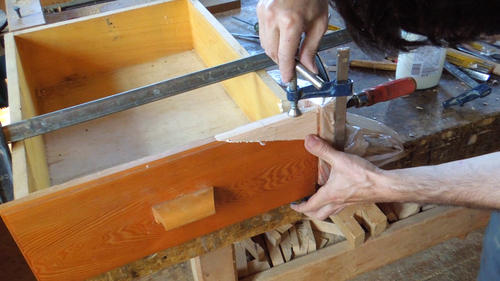 Gluing it on is a scrap tricky. If I just clamped it on, it would want to slide off to the side. So I clamped a piece of woods to the right side of the drawer to act every bit a stop. I covered that piece with a plastic bag so it wouldn't become glued on from glue squeeze-out.
Gluing it on is a scrap tricky. If I just clamped it on, it would want to slide off to the side. So I clamped a piece of woods to the right side of the drawer to act every bit a stop. I covered that piece with a plastic bag so it wouldn't become glued on from glue squeeze-out.
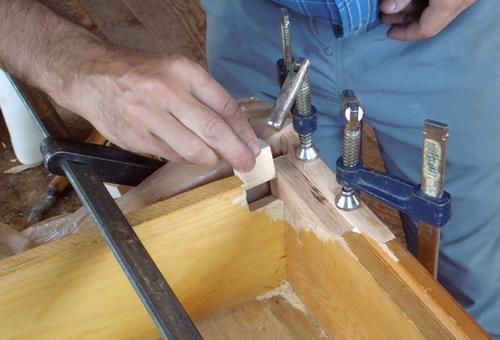 I fabricated another small-scale piece of wood to fill the gap behind the drawer forepart.
I fabricated another small-scale piece of wood to fill the gap behind the drawer forepart.
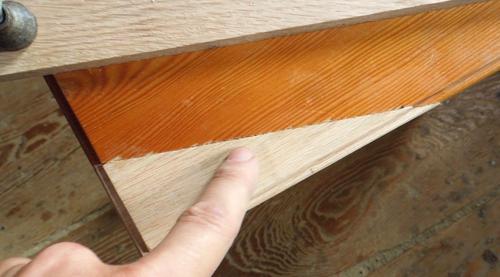 I wasn't totally happy with how information technology looked after the mucilage had stale. There was a bit of chipout from when I made the initial cutting to the drawer, and the glue joint had some gaps to information technology.
I wasn't totally happy with how information technology looked after the mucilage had stale. There was a bit of chipout from when I made the initial cutting to the drawer, and the glue joint had some gaps to information technology.
So I decided to make the drawer repair await similar an intentional accent by inlaying a darker slice of wood where the ii encounter.
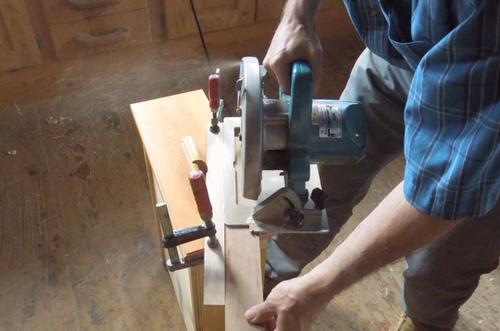 So I used a circular saw to brand a cut between the two pieces. I couldn't adjust the circular saw for a shallow plenty cut, so I put a piece of plywood between the saw and the drawer front. This also helped to protect the drawer forepart and helped prevent chipout.
So I used a circular saw to brand a cut between the two pieces. I couldn't adjust the circular saw for a shallow plenty cut, so I put a piece of plywood between the saw and the drawer front. This also helped to protect the drawer forepart and helped prevent chipout.
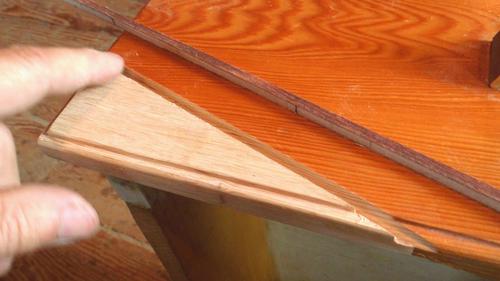 The kerf from that cut ended up clean but surprisingly wide - well-nigh five millimeters. Inspecting the bract in the saw, I realized it had quite a wobble to it, with a few teeth missing besides. In recent years my dad has not been maintaining his store and tools to the standards that he used to.
The kerf from that cut ended up clean but surprisingly wide - well-nigh five millimeters. Inspecting the bract in the saw, I realized it had quite a wobble to it, with a few teeth missing besides. In recent years my dad has not been maintaining his store and tools to the standards that he used to.
I wanted to fill that kerf with a contrasting slice of wood. But my dad only worked with solid forest that grew in the surface area, then I couldn't find anything darker than the reddish oak I already used, except for some scrap of underlay plywood, which had mahogany on both sides. Then I used that.
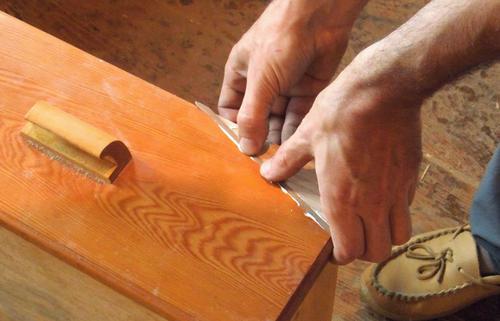 Gluing in the plywood strip...
Gluing in the plywood strip...
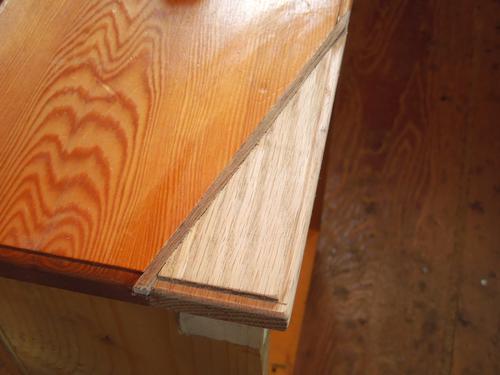 Now only need to trim the ends to lucifer the profile. This didn't work out perfectly well with the plywood. I hadn't fully thought this part through.
Now only need to trim the ends to lucifer the profile. This didn't work out perfectly well with the plywood. I hadn't fully thought this part through.
In hindsight, I should accept assorted on the light side by using some hard maple or birch, which my dad does take in his store. A thinner kerf with a less wobbly circular saw bract would besides have been better.
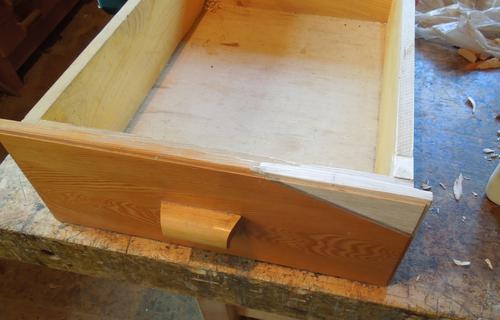 Finished repair.
Finished repair.
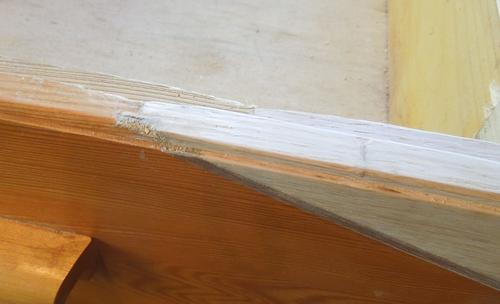 The joint looks a bit messy at the ends. I mixed some glue and sawdust to make a sort of wood filler to fill the chipout from trying to cleave the plywood.
The joint looks a bit messy at the ends. I mixed some glue and sawdust to make a sort of wood filler to fill the chipout from trying to cleave the plywood.
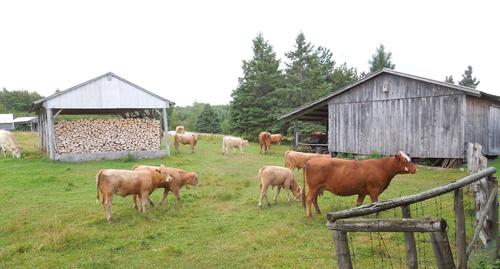 As I was doing the piece of work, the neighbor's cows came around. My parents let them graze the fields for complimentary. That keeps the fields from overgrowing. I had the store back door open the whole fourth dimension to get more than light for taking pictures and video, just fortunately, none of the cows made much noise.
As I was doing the piece of work, the neighbor's cows came around. My parents let them graze the fields for complimentary. That keeps the fields from overgrowing. I had the store back door open the whole fourth dimension to get more than light for taking pictures and video, just fortunately, none of the cows made much noise.
Source: https://woodgears.ca/drawers/repair.html

0 Response to "How To Repair A Drawer Front"
Post a Comment